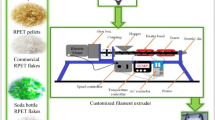Abstract
In this study, filament was produced from waste PET water bottles, and the performance of the obtained reused PET (R-PET) filament was evaluated through tensile, surface roughness, and hardness tests. The conducted tests revealed that higher infill density enhances the mechanical durability of the filament and promotes a more homogeneous structure. This study emphasizes the importance of utilizing waste PET water bottles for filament production and evaluating the performance of R-PET filament, with the aim of contributing to a sustainable production process through the reuse of plastic waste. The results of this study demonstrate that waste PET water bottles can be transformed into economic value and offer a potential solution to the plastic waste issue. Additionally, this study highlights the significance of reducing plastic waste and promoting recycling by investigating the mechanical properties of R-PET filament and exploring sustainable material options.






Similar content being viewed by others
References
Aktepe Ş, Cengiz Ö (2021) Üç Boyutlu (3D) Yazıcıların Proses Parametrelerinin Atık Termoplastik Malzemelerin Geri Dönüşüm Verimliliğine Etkileri Üzerine Bir Değerlendirme. Eğitim Publishers, Konya
Carew RM, Errickson D (2020) An overview of 3D printing in forensic science: the tangible third-dimension. J Forensic Sci 65(5):1752–1760
Chandekar A, Mishra DK, Sharma S, Saraogi GK, Gupta U, Gupta G (2019) 3D printing technology: a new milestone in the development of pharmaceuticals. Curr Pharm Des 25(9):937–945
Dave HK, Patel ST (2021) Introduction to fused deposition modeling based 3D printing process. Fused deposition modeling based 3D printing. Springer International Publishing, Cham, pp 1–21
Fico D, Rizzo D, Casciaro R, Esposito Corcione C (2022) A review of polymer-based materials for fused filament fabrication (FFF): focus on sustainability and recycled materials. Polymers 14:465
Horvath J, Horvath J (2014) A brief history of 3D printing. Mastering 3D printing. Apress, Berkeley, pp 3–10
Idrees M, Jeelani S, Rangari V (2018) Three-dimensional-printed sustainable biochar-recycled PET composites. ACS Sustain Chem Eng 6:13940–13948
Jamróz W, Szafraniec J, Kurek M et al (2018) 3D printing in pharmaceutical and medical applications—recent achievements and challenges. Pharm Res 35:1–22
Jandyal A, Chaturvedi I, Ishika Wazir I, Raina A, UlHaq MI (2022) 3D printing—a review of processes, materials and applications in industry 4.0. Sustain Oper Comput 3:33–42
Lee D, Miyoshi T, Takaya Y, Ha T (2006) 3D microfabrication of photosensitive resin reinforced with ceramic nanoparticles using LCD microstereolithography. J Laser Micro/Nanoeng 1(2):142–148
Mikula K, Skrzypczak D, Izydorczyk G, Warchoł J, Moustakas K, Chojnacka K, Witek-Krowiak A (2021) 3D printing filament as a second life of waste plastics—a review. Environ Sci Pollut Res 28:12321–12333
Praveena BA, Lokesh N, Buradi A, Santhosh N, Praveena BL, Vignesh R (2022) A comprehensive review of emerging additive manufacturing (3D printing technology): methods, materials, applications, challenges, trends and future potential. Mater Today: Proc 52(3):1309–1313
Taşdelen MA, Bingöl M, Yilmaz Y, Kahramaner H (2019) Geri dönüştürülmüş termoplastiklerin üç boyutlu yazıcılardaki performansları. In: 4th international congress on 3D printing (additive manufacturing) technologies and digital industry. Antalya, Turkey, pp 182–191
Acknowledgements
This paper is based on the fourth chapter of Ş. Aktepe’s Master’s thesis entitled “The use of 3d printers in the production of architectural lightıng elements using recycled PET material” under the supervisions of Assoc. Prof. M.Sarıkahya and Ö. Cengiz (PhD). The authors thank to Afyon Kocatepe University, Fine Arts Faculty for providing facilities.
Author information
Authors and Affiliations
Corresponding authors
Ethics declarations
Conflict of interest
On behalf of all authors, the corresponding author states that there is no conflict of interest.
Additional information
Publisher's Note
Springer Nature remains neutral with regard to jurisdictional claims in published maps and institutional affiliations.
Rights and permissions
Springer Nature or its licensor (e.g. a society or other partner) holds exclusive rights to this article under a publishing agreement with the author(s) or other rightsholder(s); author self-archiving of the accepted manuscript version of this article is solely governed by the terms of such publishing agreement and applicable law.
About this article
Cite this article
Aktepe, Ş., Sarıkahya, M. & Cengiz, Ö. Reutilization of waste PET water bottles as 3D printing filaments: a preliminary study on physical and mechanical properties of the produced filaments. Chem. Pap. 78, 2431–2435 (2024). https://doi.org/10.1007/s11696-023-03249-6
Received:
Accepted:
Published:
Issue Date:
DOI: https://doi.org/10.1007/s11696-023-03249-6




